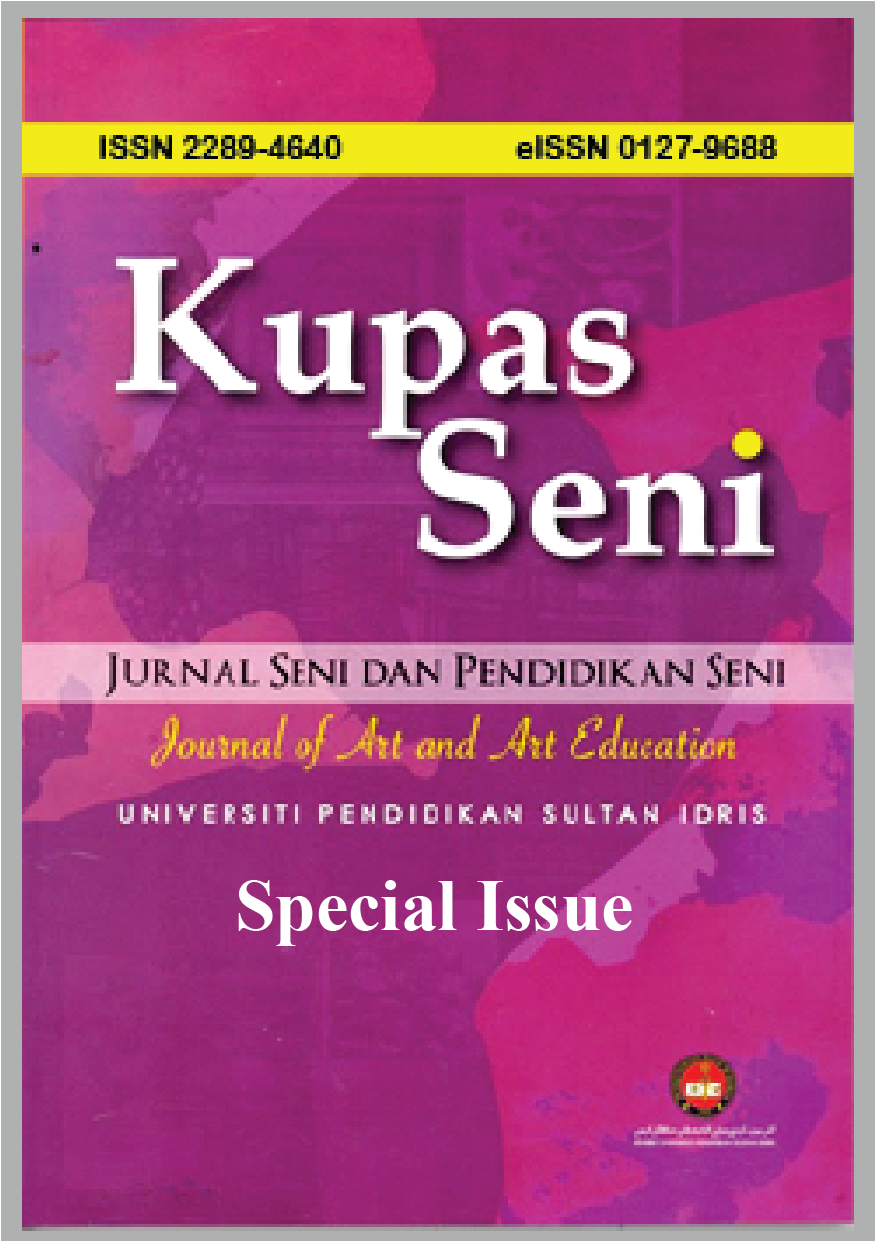Gamification in Art and Design Appreciation
DOI:
https://doi.org/10.37134/kupasseni.vol10.sp.2.9.2022Keywords:
Gamification, Quiz Whizzer, QR code, origamiAbstract
Nowadays, teaching becomes a big challenge when facing a revolution of education 4.0 to 5.0. This research conducted on the subject VCS 105 (An appreciation of art and design history), a compulsory subject for the first semester Diploma of Creative art. When the pandemic Covid-19 hit the world, the teaching and learning also changed drastically from traditional method to Online based education. The biggest problem in teaching and learning in the new norm is to attract attention from students along with the rapid development of technology. Secondly is less feedback and responds from students. Thirdly, this subject requires deeply understanding, memorize history, facts, and characters of art globally throughout the ages. The revolution of the culture of learning and thinking is not just from the cultural and societal point of view, but also having a revolution on the culture of study in class from the conventional lecture-based method. Gamification proposed as an effective approach to gain a short-term attention span among students. The researcher used the Quiz Whizzer online application as a main pillar in this study. Quiz Whizzer is website-based applications as an online educational game that provide easy means in the learning process. Furthermore, Quiz Whizzer is a game-based learning platform, used as educational technology in educational institutions. The focus of this activity is the use in making interactive games, developing the social skills, and relationships among group members. This gamification creatively combines the technology of QR code and after that creating origami techniques to produce a paper airplane as a creative craft. At the same time students use their basic theory of principle and element of art into a product design skill and psychomotor. An indicator of success is obtained when more than 85% of participants can answer the question correctly. Then, the fastest group who can create an airplane craft reach the destination (planet earth) counted as the winner. Overall, the idea to combine Quiz whizzer with origami technique is a great tool for lecturer and students for three reasons which are easily differentiate reviews for your students, incorporate collaboration and teamwork into your classes and students can apply their knowledge into skills and practice.
Downloads
References
Aisyah, & Siti. (2007) Perkembangan Dan Konsep Dasar Pengembangan Anak Usia Dini. Jakarta: PT. Indeks
Amado, C., & Roleda, L. (2019). Student Engagement in a Gamified Physics Course. Proceedings of the International Conference on Future of Education, 2(1), 85-95. https://doi.org/10.17501/26307413.2019.2109 [11] retrieved from https://www.researchgate.net/publication/336812055_Student_Engagement_in_a_Gamified_Physics_Course
Anisah, Nur. (2009) Mahir Membuat Origami Bentuk Binatang: Mengasah Kreativitas Dan Motorik Halus Anak. Jakarta: Demedia,
Boudadi, N. A., & Gutiérrez-Colón, M. (2020). Effect of Gamification on students’ motivation and learning achievement in Second Language Acquisition within higher education: A literature review 2011-2019
Cambridge Online Dictionary
Carlson, J., Harris, R. B., & Harris, K. (2017). Coin counter: Gamification for classroom management. Information Systems Education Journal, 15(5), 4. Retrieved from: http:// isedj.org/2017-15/n5/ISEDJv15n5p4.html
Çeker, E., & Ozdaml, F. (2017). What" Gamification" Is and What It's Not. European Journal of Contemporary Education, 6(2), 221-228. Retrieved from https://files.eric.ed.gov/fulltext/EJ1146137.pdf DOI: 10.13187/ejced.2017.2.221
Collins English Dictionary. (2022). HarperCollins Publishers retrieved from https://www.collinsdictionary.com/dictionary/english/qr-code
Deterding, S., Sicart, M., Nacke, L., O’Hara, K., & Dixon, D. (2011, May). Gamification. using game-design elements in non-gaming contexts. Proceedings of ACM CHI 2011 Conference on Human Factors in Computing Systems retrieved from https://dl.acm.org/doi/pdf/10.1145/1979742.1979575
Furdu, I., Tomozei, C., & Kose, U. (2017). Pros and cons gamification and gaming in classroom. arXiv preprint arXiv:1708.09337. retrieved from https://www.researchgate.net/publication/318726293_Pros_and_Cons_Gamification_and_Gaming_in_Classroom
HASANAH, Uswatun; PRIYANTORO, Dian Eka. (2019). Pengembangan Kreativitas Anak Usia Dini melalui Origami. Elementary : jurnal ilmiah pendidikan dasar, Retrieved from https://e-journal.metrouniv.ac.id/index.php/elementary/article/view/1340
Meaning of origami, Cambridge Online Dictionary (2022). retrieved from https://dictionary.cambridge.org/dictionary/english/origami
Najjar, E. A., & Salhab, R. A. (2022). Position Paper: Gamification in the Learning Process. International Journal of Online and Biomedical Engineering (iJOE), 18(01), pp. 148–153. Retrieved from https://online-journals.org/index.php/i-joe/article/view/26609/10625
Neil A. Bradbury, Attention span during lectures: 8 seconds, 10 minutes, or more?, (2016).Advances in Physiology Education Vol 40: retrieved from https://journals.physiology.org/doi/epdf/10.1152/advan.00109.2016
Quizwhizzer meaning. (2019). retrieved at https://blog.quizwhizzer.com/
Steinkuehler C. (2007). Massively Multiplayer Online Games & Education: An Outline of Research (2007) International Society of the Learning Sciences, Inc. retrieved from https://repository.isls.org/bitstream/1/3428/1/674-684.pdf
S. Snezana, Z. Nada, & T. Tripo. (2015). “Gamification in Higher Education Learning – State Of The Art, Challenges And Opportunities,” The Sixth International Conference on e-Learning (eLearning-2015), Belgrade, Serbia retrieved from http://elearning.metropolitan.ac.rs/files/pdf/2015/23-Snezana-Scepanovic-Nada-Zaric-Tripo-Matijevic-Gamification-in-higher-education-learning-state-of-the-art-challenges-and-opportunities.pdf
Treiblmaier, H., & Putz, L. M. (2020). Gamification as a moderator for the impact of intrinsic motivation: Findings from a multigroup field experiment. Learning and Motivation, Science Direct, 71, 101655. https://doi.org/10.1016/j.lmot.2020.101655
Zainuddin, Z., Chu, S. K. W., Shujahat, M., & Perera, C. J. (2020). The impact of gamification on learning and instruction: A systematic review of empirical evidence. Educational Research Review, 100326. https://doi.org/10.1016/j.edurev.2020.100326
Downloads
Published
How to Cite
Issue
Section
License
Copyright (c) 2022 Gladys Tagie, Hairulnisak Merman, Nurul Shima Taharuddin, Noor Aileen Ibrahim

This work is licensed under a Creative Commons Attribution-NonCommercial-ShareAlike 4.0 International License.





